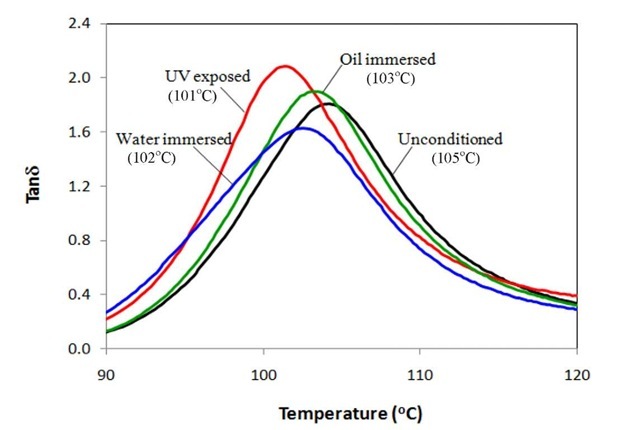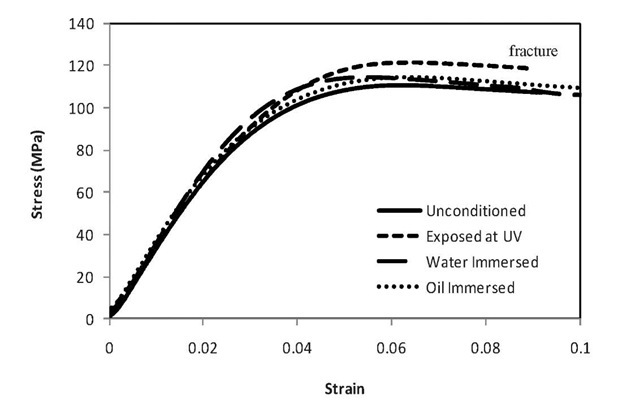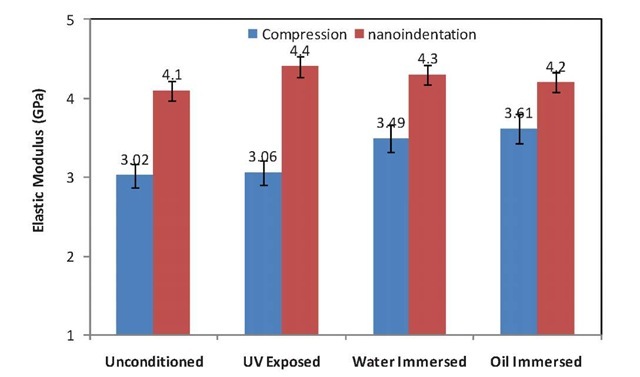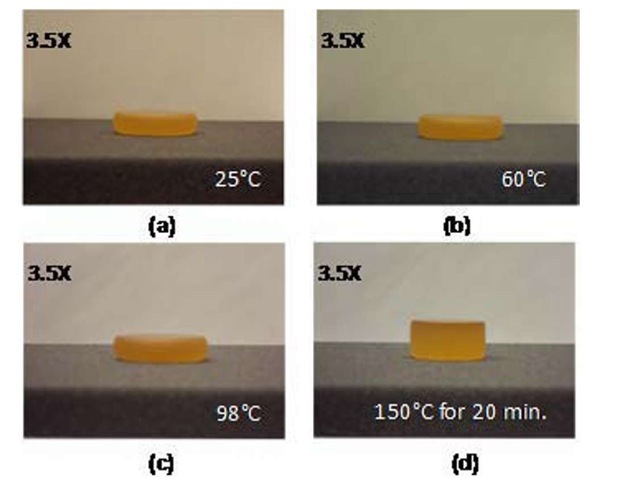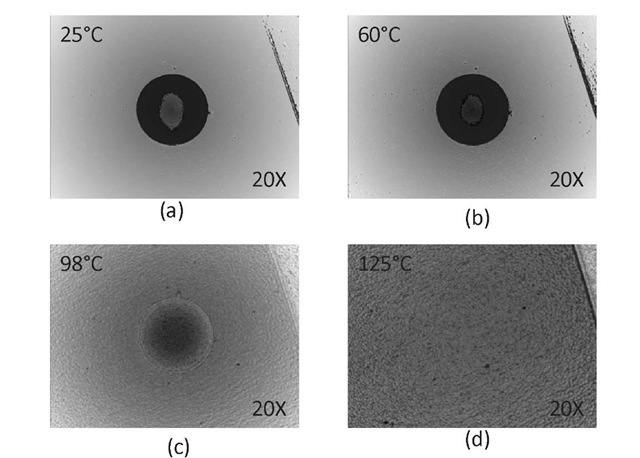ABSTRACT
Shape memory polymers (SMPs) are an emerging class of active polymers that may be used for reconfigurable structures on air vehicles. In this study, epoxy-based SMPs were conditioned separately in simulated service environments relevant to Air Force missions, namely, (1) exposure to UV radiation, (2) immersion in jet-oil, and (3) immersion in water. The mechanical properties and shape recovery abilities of the unconditioned and conditioned SMPs were examined using large-scale compressive tests and small-scale nano-indentation tests. Results show that all the conditioned SMPs exhibit a decrease in Tg as compared to the unconditioned one. Under compressive loading, the SMPs undergo significant plastic deformation prior to fracture, except the UV conditioned sample. Environmentally conditionings generally result in higher moduli and yield strength of the SMPs. Environmental conditionings, in particular the UV exposure and water immersion, also affect the shape recovery abilities of the SMPs if the recovery temperatures are set low.
INTRODUCTION
Shape memory polymers (SMPs) are novel class of active polymers that have been considered for the development of reconfigurable air vehicles. SMPs have the ability to change shape in a predefined way from a temporary shape to a permanent shape when activated at the so-called the activation temperature (Td), usually above their glass transition temperatures (Tg). The temporary shape is obtained by mechanical deformation and subsequent fixation of that deformation. Upon application of an external stimulus such as heat, the polymer starts to recovers. The temperature at which the material is made to recover will be called as the recovery temperature (Tr). The typical thermomechanical cycles used to quantify the shape-memory behavior of the SMPs have been described by Lendlein and Kelch [1], Beloshenko et al. [2], Liu, et al. [3-4], Behl and Lendlein [5], Ratna and Karger-Kocsis [6], Wei et al. [7], Schmidt et al. [8], Gall et al. [9], Tobushi, et al. [10-11], and Atli, et al. [12]. So far, little work has been carried out to investigate the durability of the SMPs in anticipated service environment. Like conventional polymers, the shape memory polymers will undergo physical and chemical aging when exposed to simulated service environments. Failure of the morphing materials in aggressive environments will have a direct impact on reconfigurable ability of the aircrafts and fleet readiness of aerospace missions. It is thus critical to examine the shape recovery ability and mechanical properties of SMPs conditioned at relevant service environments so that the true reconfigurable ability of the SMPs can be predicted. This paper presents multiscale mechanical characterizations of the SMPs conditioned at water, jet oil, and UV environments.
EXPERIMENTATION
Materials
The SMP chosen for this study was an epoxy-based thermosetting resin (Veriflex-E) developed by Cornerstone Research Group, Inc. (CRG). Two types of samples were fabricated: thin square plaques measuring 300 mm by 300 mm with an average thickness of 3.2 mm and cylindrical buttons with nominal diameter of 25.4 mm and nominal thickness of 12.7 mm. The plaque samples were further cut into smaller specimens (22 mm length x 10 mm width x 3.2 mm thickness) with water-jet machining. The SMP specimens were environmentally conditioned as follows.
Conditioned in water In order to evaluate the hot-wet performance of SMPs, specimens were immersed in water at 49°C for four days (following the water immersion procedure described in MIL-PRF-23377H paragraph 4.6.6.). Care was taken to ensure that the water used for the immersion met ASTM D 1193 Type IV water with a minimum of 0.2 MOhm electrical resistivity.
Conditioned in lube oil SMP specimens were immersed in MIL-L-23699 lubricating oil at room temperature for 24 hours to isolate the influence of lubricating oil alone.
Conditioned by UV radiation The accelerated weathering conditioning was performed in a Xenon-Arc exposure chamber. The button samples were placed in a specialized basket to allow the majority of the surface to be exposed to the UV radiation. The standard exposure cycle is 102 minutes of light only followed by 18 minutes of light and water spray. High purity deionized (DI) water with a minimum of 16.5 MegOhms-cm resistivity was used. During the light only, the black panel temperature in the exposure chamber was controlled to 63°C + 2.5°C, and the intensity of the spectral irradiance was controlled to 0.3 to 0.4 watts/meter2 at a wavelength of 340 nm. Humidity in the chamber was not controlled. Exposure length was limited to 125 cycles.
Transition temperature
The glass transition temperatures of the SMPs were characterized with a dynamic mechanical analyzer (DMA), Model Q800 from TA Instrument. Conditioned and unconditioned SMPS cut from the thin plaques were tested in torsion mode. Tests were scanned from 25oC to 130oC with a heating rate of 2oC/min. The applied strain was 0.1% and the oscillating frequency was 1Hz.
Mechanical Characterization
Large-Scale Compression Tests The mechanical properties of the SMPs were first examined through large-scale compression tests at ambient temperature (25°C). A MTS LandMark with FlexTest 40 machine was used to perform all of the compression tests for the current study. All test were done utilizing displacement control. A capacitive displacement sensor was used to measure the displacements for all ambient compression tests. Each specimen was loaded to a level of strain of 10% of the sample initial undeformed height. A loading time of 5 minutes was used for each test, which resulted in a strain rate of 0.00034/s. The specimen was initially loaded with a 1?? MPa stress to ensure the sample-plate contact. Once loaded, the initial capactive displacement was recorded. The specimen was then loaded to the prescribe level of strain and then unloaded.
Nanoindentation Tests The mechanical properties of the SMPs were further evaluated through nanoindentation tests. The Nano Indenter XP (MTS NanoInstruments, Oak Ridge, TN) equipped with a Berkovich diamond indenter was used in the experiments. The indenter has a nominal tip radius <20 nm and an inclined angle of 65.3 (degree). For nanoindentation studies, the surface of SMP specimen was prepared by successive polishing, the final polishing being an alumina compound with an average particle size of 0.3 ^m. The "held-at-the-peak" method was used, which is a special technique that was proposed for testing polymer and soft materials [13]. The nanoindentation tests were conducted at a loading rate of 5 mN/s. The indenter holding time at the maximum load was 5 s. A total of 10 measurements were conducted on each specimen.
Shape Recovery Ability
Large-Scale Compression Tests The shape memory behaviors of the SMPs were first examined on cylindrical button specimens. For these experiments, the oven and liquid nitrogen cooling system were incorporated into the same MTS Landmark machine. To help ensure even loading and proper deformation two metal plates were used to augment the contact area between the mandrels and specimen. The specimen was inserted into the machine and loaded initially with a 0.02 MPa stress to help ensure contact before being heated. A 30 minute ramp time was used to heat the specimen to 130°C and then a 30 minute dwell time was used to ensure thermal equilibrium. Once the specimen was heated the specimen was deformed to a level of 30% strain from its original undeformed height. The 30% strain level with a 5 minute loading resulted in a strain rate of 0.001/s. Once the apporiate strain level was reached the displacment was held constant and the specimen was cooled at a ramp time of 30 minutes. Each specimen was measured and weighted before beginning the recovery process. For recovery measurements, a MTI KSL 1100X oven was used to heat each specimen to the prescribed recovery temperatures (60°C, 93°C, 98°C, 125°C, 135°C, 150°C). A dwell time of 8 minutes was used for each stage of recovery and at each stage the samples were measured and photographed to help quantify and qualifiy the shape recovery ability of the SMP.
Nanoindentation Tests The shape memory behavior of the SMPs was further examined at small scales by using the high temperature nanoindentation apparatus. A spherical indenter of 300 ^m tip diameter was used. First, the specimen was heated to a deformation temperature 130°C. The heating rate was approximately 2oC/min. The actual temperature in the specimen was monitored through thermocouples placed near the specimen. The specimen was kept at this temperature for at least 1-hr to allow the temperature in the specimen reach equilibrium. The specimen was then deformed with the indenter with a maximum load of 50 mN at a loading rate of 5 mN/s. While the indenter was maintained at that load, the temperature in the sample was brought to room temperature and then the indenter was withdrawn from the specimen. It took approximately two hours for the sample to reach the room temperature after the heater was turned off. The surfaces of the specimens were then examined with a Wyko Optical Surface Profiler (Veeco Instruments, Inc.) for the initial indentation profile and indentation depth measurements. Subsequently, the specimen was placed back on the indenter microheater stage for recovery experiments. The recovery experiments were conducted at various temperatures (Tr): 60oC, 75oC, 93oC, 98oC, 125oC. A 2 minutes dwell time was used for all experiments. The indentation profile at each recovery temperature was next obtained by scanning the surface of the recovered specimen with the Wyko Optical Surface Profiler.
RESULTS AND DISCUSSION
Glass transition temperatures
Effect of environmental conditioning on the physical properties of the SMPs was first examined. Figure 1 depicts the Tan(5) curves of the unconditioned and conditioned SMP specimens measured using a DMA (Dynamic Mechanical Analyzer). From the curves, the glass transition temperature (Tg) of each SMP was determined (the peak of the Tan(5) curve). It is seen that the transition temperature of the unconditioned SMP occurs at 105oC while the onset of glass transition is at approximately 90oC (from the temperature dependence of storage modulus not shown here). After conditioning, all SMPs are seen to exhibit a decrease in Tg in comparison to the unconditioned one. Among them, the UV exposed SMP has the largest decrease in Tg (101oC).
Mechanical properties
The mechanical behaviors of the SMPs as results of environmental conditioning were examined using large scale compression tests and small scale indentation tests. Figure 2 shows the stress-strain responses of the unconditioned and conditioned SMPs from the compressive tests at ambient temperature. Under compressive loading, the SMP resins undergo significant plastic deformation following yielding. These observations are in contrast with the tensile testing results reported earlier, where the SMPs exhibit primarily liner elastic deformation [14]. Environmental conditionings have affected the deformation of the SMPs. The UV exposed SMP is seen to have limited ductility; the specimen became brittle and broke into pieces before the prescribed strain of 10% was reached. Environmental conditionings have also increased the modulus and yield strength of the SMPs. The UV exposed sample was seen to have the greatest increase in yield strength (121 MPa), in comparison with the unconditioned one (110 MPa). Figure 3 shows the elastic moduli of the unconditioned and conditioned SMPs obtained from large scale compression tests and small scale indentation tests. The compressive moduli were determined by the slopes of the initial linear portion of the stress-strain curves of the SMPs (Figure 2). The indentation moduli were determined from the parameters obtained on the load-depth curves, as documented in reference [13]. Nanoindentation test was conducted since it had been proven to be a useful technique for examining the local deformation of polymers as a result of environmental aging [15, 16]. Like conventional polymers, the shape memory polymers will undergo physical and chemical aging when exposed to simulated service environments. Detailed surface examinations have shown that the UV exposure SMP specimens have developed yellow tints throughout the entire specimens and exhibited noticeable surface roughness compared to an unconditioned specimen. All conditioned specimens are seen to exhibit higher modulus than the unconditioned specimen, indicating the onset of brittleness when exposed to radiation and fluids.
Figure 1. Tan(8) curves of the unconditioned and conditioned SMPs measured using the DMA in torsion mode. Numbers shown in parentheses are the glass transition temperatures.
Figure 2. Stress-strain curves of the unconditioned and conditioned SMPs from large scale compression tests.
Figure 3. Elastic modulus of the unconditioned and conditioned SMPs obtained from large scale compression tests and nanoindentation tests.
Shape recovery ability
Effect of environmental conditionings on the shape recovery ability of the SMPs was also examined at various scales. The shape recovery experiments were conducted according to the standard shape memory cycle. First, specimens were heated to a deformation temperature Td=130oC (>Tg) and then deformed (large compression or small indentation). When deforming, the temperatures in the sample were brought to room temperature and then the constraints were removed from the specimens. Subsequently, the specimens were placed back on the heating stage for recovery measurements.
For large scale shape recovery experiments, the large button specimens were used (25.4 mm diameter x 12.8 mm thickness). The prescribed compressive strain at fixing was ~40%. At each recovery temperature (25oC, 60°C, 98°C, 125°C, 135°C, 150°C), the specimen was photographed and height measured to quantify and qualify the shape recovery process of the SMP. For each of the recovery temperatures a dwell time of 8 minutes was used. Figure 4 shows the typical photographs representing the shape recovery profiles of the unconditioned SMP. The shape recovery of the SMP was seen to be very limited at temperatures below the Tg. Once the temperature exceeded the transition temperature, recovery was seen to increase. The UV exposed and water immersed samples had the lowest level of recovery when the unconditioned specimen achieve almost full recovery. However, all specimens were within 5% of achieving full recovery.
For small scale shape recovery experiments, the newly modified high temperature nanoindentation was used. The high temperature nanoindenter consisted of the Nano Indenter XP equipped with a microheater assembly. Smaller specimen (10 mm length x 5 mm width x 3.2 mm thickness) was used. During activation, a spherical indenter of 150 |am radius was used to indent the specimens, which resulted in the prescribed strain of approximately 6%. Recovery experiments were performed at several different temperatures (25oC, 60oC, 98oC, and 125°C). A 2-minute dwell time was used for all experiments. As each SMP specimen was re-heated, a microscope incorporated with the nanoindenter equipment was used to closely monitor the recovery process. The SMP surface was then examined using the Wyko Optical Surface Profiler to obtain the corresponding indentation profile and dimensions. Results show that the indent recoveries are negligible when the material is in the glassy state (25oC, 60oC). As the recovery temperature is increased above the onset of the glass transition (98oC), the indents begin to show significant recoveries. However, at this temperature, the UV exposed and water immersed SMPs have smaller recovery ratios in comparison to the unconditioned resin. Finally, as the SMP resin is re-heated above its Tg to 125oC, the indents are nearly 100% recovered for all specimens. Overall, the material’s ability to regain shape remains relatively unchanged with conditioning, as long as the recovery temperature is sufficient high. Larger specimens require longer hold times at recovery temperatures.
Figure 4. Large scale shape recovery experiments for the unconditioned SMP sample.
Figure 5. Small scale shape recovery experiments for the unconditioned SMP sample.
CONCLUSIONS
Multiscale experiments were conducted to characterize an epoxy-based SMP separately exposed to moisture, lubricating oil and UV radiation. Results show that environmental conditioning affects the glass transition temperature, the mechanical properties, and the shape recovery abilities of the SMPs. It appears that all the conditioned SMPs exhibit a decrease in Tg as compared to the unconditioned one. The environmental conditioning also affects the modulus and yield strength of the SMPs. Most conditioned SMPs exhibit higher yield strength than the unconditioned SMP. In particular, the UV conditioned specimen is seen to have the highest increase in yield strength indicating onset of brittleness with exposure to radiation. The shape recovery ability of the SMP was assessed through both large and small recovery experiments according to the standard shape memory cycle. Both large-scale and small-scale testing show that the recovery is limited below the glass transition temperature (Tg), but the amount of recovery increases as the recovery temperatures are increased above Tg. Overall, the UV exposed and water-immersed SMPs exhibit lower shape recovery ratios as compared with the unconditioned one.
